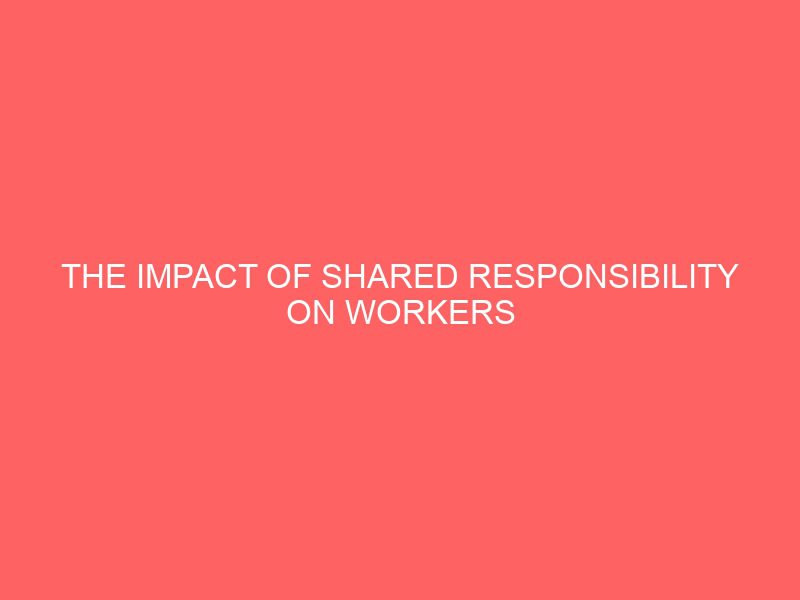Description
CHAPTER ONE
INTRODUCTION
1.1 BACKGROUND TO THE STUDY
Considering its prominent place in the prevailing organizational discourse, shared responsibility has proven to be a favorite formula for organizational redesign. It is a promising concept which offers autonomy, responsibility and job enrichment in order to meet the aspirations of the employees. At the same time, shared responsibility is believed to enhance performance outcomes such as productivity and quality, on both the team and the organization level. Hence, management fashions such as business process re-engineering, lean production, the modern socio-technical approach and human resources management (HRM), all embrace the core principles of shared responsibility (Benders and Van Hootegem, 1999; de Sitter et al., 1997; Kuipers and van Amelsvoort, 1990).
A major argument for introducing and for developing shared responsibility in an organization stems from recent insights into the impact of human resources on organizational performance and productivity. In the current debate on HRM, the resource-based view of the firm states that the intangible, imperfectly imitable and imperfectly substitutable internal resources of the organization enable a firm to generate and to sustain its competitive advantage (Doorewaard andMeihuizen, 2000). This statement is true especially with regard to the impact of human resources on organizational performance and productivity in organizations that practices shared responsibility. Shared responsibility encourages team-based work. The performance in team-based working largely depends on the employees’ competencies and attitudes with regard to planning, performing and controlling team tasks in an autonomous way.
When analyzing which features of shared responsibility at work can add to the enhancement of team performance which can only be achieved with team work i.e. the division of job regulation tasks between team leader and team members. A larger allocation of job regulation tasks within the team among the team members is supposed to contribute more effectively to organizational goals than the allocation of these tasks to a separate team leader. However, hardly any empirical evidence exists regarding the relationship between shared responsibility structure and shared performance (Benders et al., 1999). This study is aimed at clarifying the impact of the structure of shared responsibilities on workers’ productivity considering its current challenges.
1.2 STATEMENT OF THE PROBLEM
Apart from the variety of job regulation tasks in an establishment, the nature of the division of responsibilities is important in order to analyze the influence of the shared responsibility structure on organizational and worker’s performance and productivity. According to Benders and Van Hootegem (1999), the concept of shared responsibility is rather vaguely elaborated. Sometimes, shared responsibility is conceptualized as being the autonomy of the team as a whole, whereas at other times the concept strictly refers to the responsibility of individual team members. Bryman’s analysis (1996) of leadership appears to be adequate in providing a further elaboration of the concept of shared responsibility. This focuses on leadership as a process, rather than on leadership as a formal position within an organization. As a process, leadership consists of a set of decisions concerning the coordination and regulation of work processes. Such a decision-making process can be organized in many different ways. In teams with autocratic or participatory leadership, for example, the responsibility for decisions is located within a formal position of team leader. In teams with shared responsibility (where a team leader appears to be absent), team members themselves make all the decisions. In day-to-day practices, various hybrid structures of shared responsibility exist (for example, the shared responsibility for work preparation, support and control might be restricted to a few team members only, or responsibilities might be divided among various team members).
For the purpose of this study, the researcher seeks to examine the impact of shared responsibility on workers’ productivity in government owned establishment carefully looking at its current challenges. However, in shared responsibility structure, team members themselves make decisions concerning work preparation, support and control in an autonomous way which also be highlighted in this study.
1.3 OBJECTIVES OF THE STUDY
The general objective of this study is to analyze the impact of shared responsibility on worker’s productivity in government own establishment vis-a-vis study on its current challenges while the following are the specific objectives:
To examine the impact of shared responsibility on worker’s productivity in government own establishment.
To identify the challenges of shared responsibility in government own establishment.
To examine the different structures of shared responsibility that can enhance worker’s productivity.
1.4 RESEARCH QUESTIONS
What is the impact of shared responsibility on worker’s productivity in government own establishment?
What are the challenges of shared responsibility in government own establishment?
What are the different structures of shared responsibility that can enhance worker’s productivity?
1.5 HYPOTHESES
Hypothesis 1
HO: Shared responsibility cannot enhance workers productivity in government own establishment
HA: Shared responsibility can enhance workers productivity in government own establishment
Hypothesis 2
HO: Shared responsibility has no challenges in government own establishment
HA: Shared responsibility has challenges in government own establishment
1.6 SIGNIFICANCE OF THE STUDY
The following are the significance of this study:
Findings from this research work will educate head of governments, administrators and managers of corporate organizations on the impact of shared responsibility on workers productive as it will also throw light to its challenges thereby making this research work a guide for the stakeholders in decision making.
This research will be a contribution to the body of literature in the area of the impact of shared responsibility on worker’s productivity in government own establishment, thereby constituting the empirical literature for future research in the subject area.
1.7 SCOPE/LIMITATIONS OF THE STUDY
This study on impact of shared responsibility on worker’s productivity in government own establishment vis-a-vis study on its current challenges covers all the Human resource services in government establishment in Nigeria. The study will also cover an overview of factors hindering worker’s productivity and the challenges of shared responsibility.
LIMITATION OF STUDY
Financial constraint- Insufficient fund tends to impede the efficiency of the researcher in sourcing for the relevant materials, literature or information and in the process of data collection (internet, questionnaire and interview).
Time constraint- The researcher will simultaneously engage in this study with other academic work. This consequently will cut down on the time devoted for the research work.
1.8 DEFINITION OF TERMS
Responsibility: A duty or obligation to satisfactorily perform or complete a task (assigned by someone, or created by one’s own promise or circumstances) that one must fulfill, and which has a consequent penalty for failure.
Productivity: A measure of the efficiency of a person, machine, factory, system, etc., in converting inputs into useful outputs.
Productivity is computed by dividing average output per period by the total costs incurred or resources (capital, energy, material, personnel) consumed in that period. Productivity is a critical determinant of cost efficiency.
Performance: The accomplishment of a given task measured against preset known standards of accuracy, completeness, cost, and speed. In a contract, performance is deemed to be the fulfillment of an obligation, in a manner that releases the performer from all liabilities under the contract
Team: A group of people with a full set of complementary skills required to complete a task, job, or project.
Team members:
(1) Operate with a high degree of interdependence,
(2) share authority and responsibility for self-management,
(3) are accountable for the collective performance, and
(4) work toward a common goal and shared rewards(s).
A team becomes more than just a collection of people when a strong sense of mutual commitment creates synergy, thus generating performance greater than the sum of the performance of its individual members.
REFERENCES
Benders, J. and Van Hootegem, G. (1999), “Teams and their context. Moving the team discussion beyond existing dichotomies’’, Journal ofManagement Studies, Vol. 36 No. 1.
Benders, J., Huijgen, F. and Pekruhl, U. (1999), “Group work in the European Union, results from a survey’’, paper presented at the 17th Annual International Labour Process Conference, London, 29-31 March.
Bryman, A. (1996), “Leadership in organizations’’, in Clegg, S.R., Hardy, C. and Nord, W. (Eds), Handbook of Organization Studies, Sage, London.
de Sitter, L.U., den Hertog, J.F. and Dankbaar, B. (1997), “From complex organisations with simple jobs to simple organisations with complex jobs’’, Human Relations, Vol. 50 No. 5, pp. 497-534.
Doorewaard, H. and Meihuizen, M.E. (2000), “Strategic options in professional service organisations’’, Human ResourceManagement Journal, Vol. 10 No. 2, pp. 39-57.
Kuipers, H. and van Amelsvoort, P. (1990), Slagvaardig organiseren, Kluwer Bedrijfswetenschappen,Deventer.







